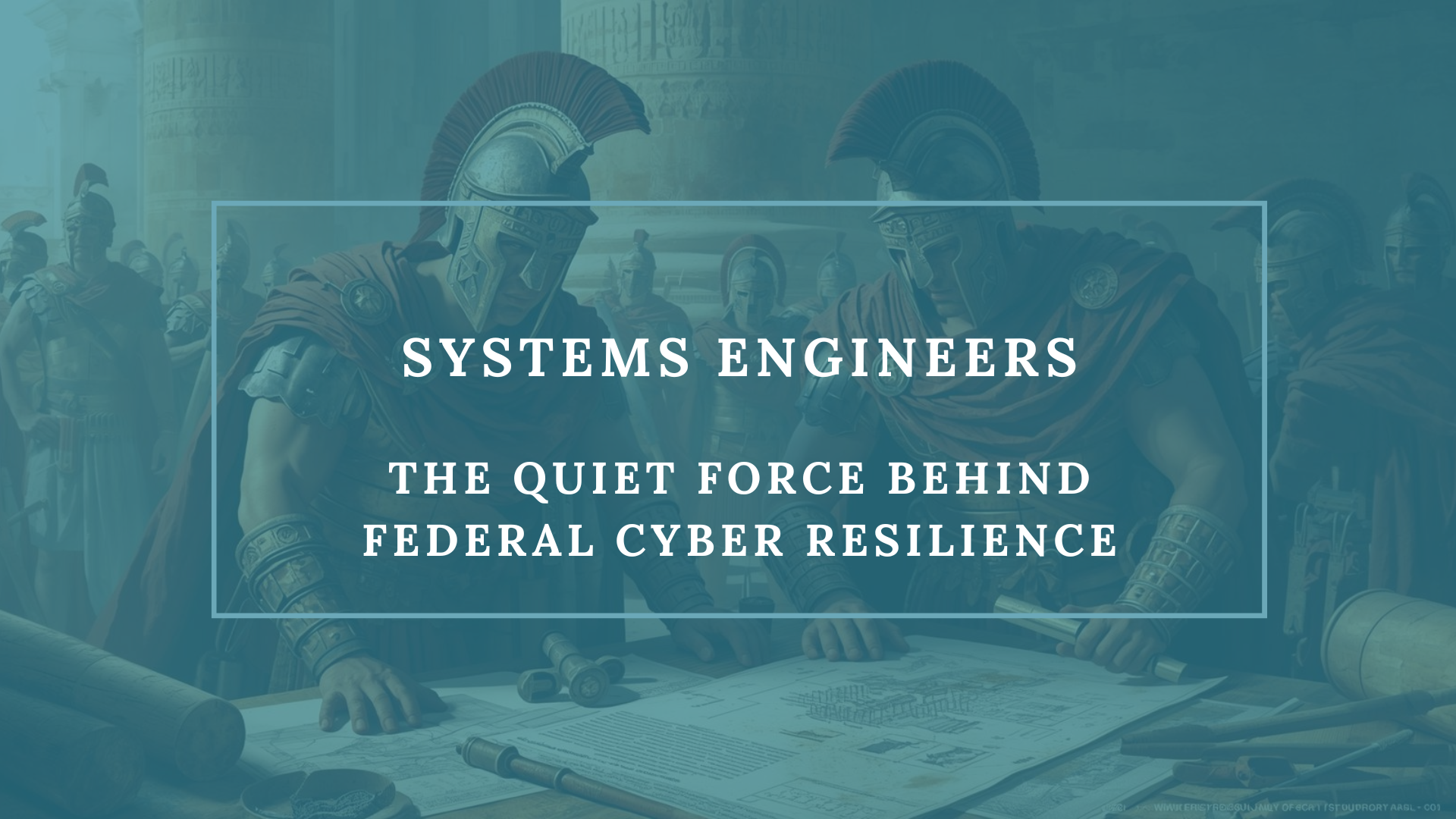Systems Engineers: The Quiet Force Behind Federal Cyber Resilience
The Overlooked Role in Federal Cybersecurity
Cybersecurity in the federal government often gets framed around tools: firewalls, encryption, cloud platforms, and threat detection systems. But the real enabler of cyber resilience isn’t just technology, it’s the discipline of systems engineering.
These engineers are the unseen backbone of federal IT, blending security and technical precision with governance, risk, and compliance (GRC) discipline. They bring the structure, foresight, and integration mindset required to transform complex policy mandates into operational reality. Without their influence, agencies often bolt on security and compliance as afterthoughts, resulting in fragile architectures that may pass audits temporarily but ultimately fail to deliver resilience or mission readiness.
In an era where adversaries move fast, budgets are tight, and compliance is non-negotiable, systems engineers are not just IT staff. They are mission enablers.
Cyber Resilience is More Than Defense
For federal agencies, cyber resilience isn’t only about defending against hackers, it’s about ensuring the mission continues, even in the face of disruption.
That could mean keeping citizen services online during a ransomware campaign, sustaining command-and-control capabilities during a denial-of-service attack, or rapidly adapting to new compliance frameworks like FedRAMP 20X or OMB’s Zero Trust strategy.
Here, systems engineers work side by side with GRC engineers to design resilience into the DNA of federal IT systems by:
- Anticipating failures and building architectures that survive them.
- Embedding risk management into design trade-offs (cost, performance, compliance).
- Balancing usability and security so systems remain both safe and mission-ready.
- Automating governance checks so compliance is continuous, not episodic.
Resilience isn’t just technical hardening, it’s governed, auditable, and adaptable.
Translating Policy Into Practice
The federal IT landscape is shaped by a constant stream of mandates, FISMA, FedRAMP, Zero Trust, Executive Orders, OMB memoranda like M-24-15, and agency-specific requirements. The challenge isn’t just understanding these policies; it’s implementing them in ways that support, rather than slow down, mission operations.
That’s where systems engineers shine, and act as translators between the language of policy and the realities of architecture and code. For example:
- FedRAMP 20X: Automation pipelines replace static security packages with real-time, machine-verifiable dashboards.
- Zero Trust: Identity, access, and data flow controls are aligned into a coherent architecture, not just a collection of point solutions.
- Continuity of Operations (COOP): System interdependencies are modeled so critical functions survive outages or attacks, with risks quantified and mitigations documented.
Without this discipline, policies risk becoming checkbox exercises. With it, they become living, enforceable design principles.
Lifecycle Thinking: Designing for Decades, Not Months
Federal IT systems don’t get retired after a few years, they live for decades, through shifting administrations, evolving missions, and emerging threats. That longevity makes lifecycle systems thinking essential.
Systems engineers apply discipline across the full continuum:
- Requirements analysis: Identifying mission-critical functions and compliance boundaries before the first line of code is written.
- Secure design: Embedding Zero Trust, defense-in-depth, and compliance automation from day one.
- Sustainment: Engineering for patchability, scalability, and auditability, ensuring controls evolve with the threat landscape.
- Modernization: Keeping systems current and compliant, so agencies don’t get locked into brittle legacy anchors.
The OPM breach of 2015 is a cautionary tale: legacy systems without modern controls left millions of personnel records exposed. Stronger systems engineering discipline could have ensured resilience and compliance were designed in long before disaster struck.
Enabling Business Services and Mission Outcomes
In government, “business services” aren’t about revenue, they’re about enabling agencies to function efficiently and deliver on their mission.
Systems engineers enable services to be secure, resilient, and compliant:
- Identity Services: From PIV cards to Login.gov, engineered to be user-friendly, fraud-resistant, and audit-ready.
- Cloud Services: Secure landing zones and continuous monitoring pipelines that meet FedRAMP, DoD CC SRG, and OMB Zero Trust requirements.
- Critical Infrastructure: Security and compliance integrated into every operational layer to ensure mission services are available when needed most.
By embedding both resilience and compliance into these services, agencies don’t just meet mandates, they empower their workforce and serve citizens more effectively.
Why This Matters Now
The federal IT environment is at a turning point. Agencies are expected to modernize quickly, deliver services seamlessly, and defend against evolving threats, all under tighter scrutiny from OMB, Congress, and the public.
Three forces are converging:
- Compliance Acceleration: FedRAMP 20X is pushing agencies toward automation and real-time verification.
- Zero Trust Strategy: Agencies must fundamentally re-architect access and identity models across distributed systems.
- Mission Continuity Pressure: From election security to global conflicts, cyber resilience has become a national security issue.
Meeting these demands requires more than tools, it requires the combined discipline of systems and GRC engineering to design, integrate, and sustain resilience.
How InfusionPoints Helps Agencies Build Resilience
At InfusionPoints, we’ve seen firsthand how systems transform federal IT from fragile to resilient. Our approach is rooted in:
- Security Infused at Every Point in the Solution Development Lifecycle: Governance, risk, and compliance are integrated across the lifecycle, making resilience a byproduct, not a patch.
- Compliance as Code: Automating FedRAMP, DoD CC SRG, and Zero Trust requirements so agencies spend less time on paperwork and more on mission.
- Mission-Ready Architectures: Designing systems that withstand disruption, scale with demand, and evolve with changing policy.
- Practical Experience: From cloud landing zones to continuous monitoring pipelines, we’ve helped agencies turn complex mandates into working solutions.
We don’t just help agencies check the compliance box, we help them operationalize resilience.
Closing Thought
Systems engineering isn’t just about technical design, it’s about enabling agencies to modernize securely, prove compliance continuously, and deliver on their mission.
Cyber resilience is no longer optional for the federal government; it’s a mission imperative. And it’s systems engineers, are the quiet force behind the scenes, that make it possible.
InfusionPoints stands ready to help agencies design, build, and sustain cyber resilient systems that enable business services and secure mission outcomes.
Because cyber resilience isn’t a tool you buy. It’s an outcome you design.
References:
FedRAMP 20x https://www.fedramp.gov/20x
CISA Resilience Services https://www.cisa.gov/topics/critical-infrastructure-security-and-resilience/resilience-services
MITRE Cyber Resiliency Framework https://www.mitre.org/news-insights/publication/cyber-resiliency-framework-and-cyber-survivability-attributes
More Fun Reading from our own minds:
https://infusionpoints.com/blogs/system-thinking-one-bite-sized-chunk-time


